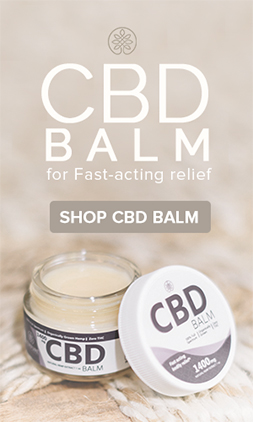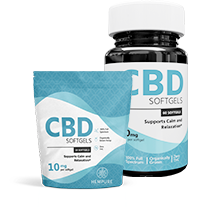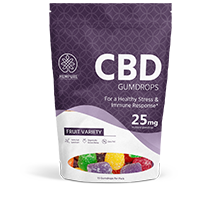What are hemp terpenes?
Sabina King on Nov 15th 2019
Chances are if you’re interested in health and wellness trends, you’ve heard of CBD or cannabidiol. You may also know of the many benefits of this hemp-derived compound, from stress and pain relief to general immune support. Recently, however, new components of the hemp plant are causing quite a stir for their beneficial properties. These components, known collectively as terpenes, have been a topic of interest for researchers recently because of their therapeutic potential. What do these little-known compounds do, and how can they work for you?
What are terpenes?
You may not have heard of it, but you’ve been exposed to terpenes your whole life. Terpenes and terpenoids are aromatic organic hydrocarbons found in several plants and a few insects too. These compounds give plants their unique scents, and were developed through evolution to either ward off animals that may eat the plants, or attract pollinators. All aromatic essential oils contain high quantities of terpenes. In fact, aromatherapy is pretty much solely based on the therapeutic effects of terpenes. Perfumes and foods also use terpenes for flavoring. Your cup of evening chamomile tea, your lavender scented bath salts – they all contain a combination of terpenes.
What are cannabis terpenes and hemp terpenes?
A lot of the recent conversation around terpenes has focused on cannabis, mostly because the cannabis plant is extremely rich in terpenes. Recreational marijuana users will know that different strains smell different, a distinction which is largely because of the terpene content of each strain. But experts say these do more than just distinguish strains by scent – they also affect how marijuana affects the user. The difference between a ‘lazy high’ and a ‘focused high’ may be simply a result of terpenes in the plant. Research suggests that terpenes can have calming, sinus-clearing, or focus-enhancing properties when inhaled or tasted.[1][2][3]
Hemp, being a species of cannabis, is extremely terpene-rich. Over 100 different terpenes in hemp are currently being researched to determine how they can affect the body when consumed. What’s interesting is that effects of an individual terpene seem to change when combined with other terpenes, and researchers attribute this to something called the entourage effect.[4] The entourage effect was put forward by noted cannabis researcher Ethan Russo, who discovered that the cannabis plant contains a variety (or an ‘entourage’) of active compounds, in addition to the cannabinoids we are most familiar with, that regulate the effects of one another. For instance, these compounds – cannabinoids, terpenes, terpenoids and flavonoids can reduce the side effects of certain compounds and enhance the effects of others. This is primarily why terpenes in other plants may not have the same effect on you as they would when combined with cannabinoids.
Terpenes v/s terpenoids
The distinction between terpenes and terpenoids lies in the extraction process. Terpenes are the more natural version of terpenoids, developed on the plant as it grows. Terpenoids develop when the plant is dried out and cured. The process of drying changes the way that the terpene molecules smell and taste.
Common terpenes in hemp.
There are a few different terpenes that are commonly found in hemp, each with its own benefits.
Pinene
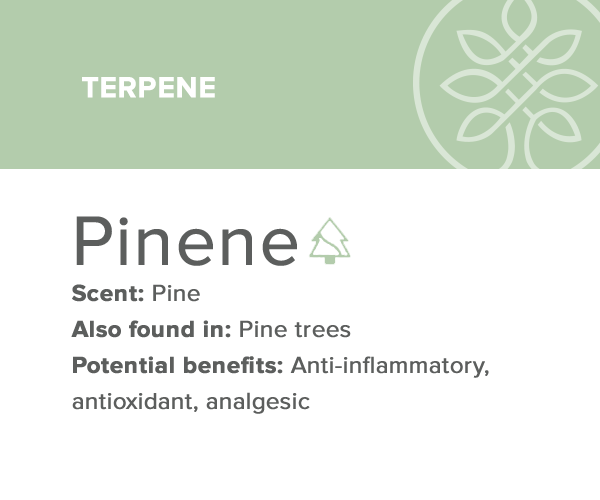
Scent: Pine
Also found in: Pine trees
Potential benefits: antioxidant, antibacterial, analgesic (pain relieving) agent.
Linalool

Scent: Floral with spicy overtones
Also found in: Lavender, basil
Potential benefits: Analgesic, calming, mood enhancing agent.
Myrcene

Scent: Earthy, fruity
Also found in: Lemongrass, mango
Potential benefits: Calming, sedating, anti-spasmodic (muscle relaxing) agent.
Limonene

Scent: Citrusy
Also found in: Citrus fruits
Potential benefits: Mood enhancing, calming, immune supporting agent.
Caryophyllene

Scent: Spicy
Also found in: Clove, rosemary
Potential benefits: Analgesic, antibacterial, calming agent.
Humulene
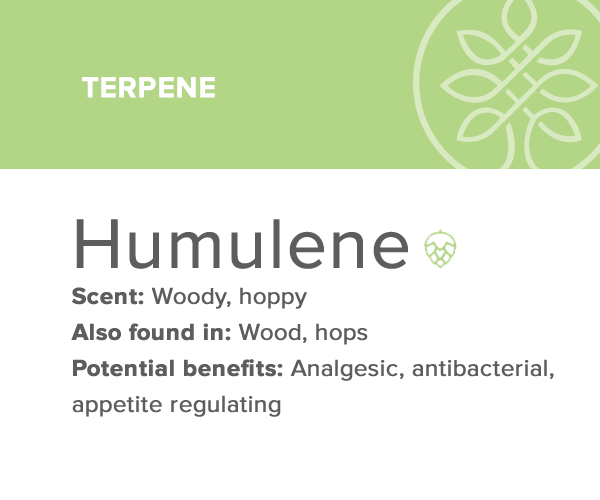
Scent: Woody, hoppy
Also found in: Hops, wood
Potential benefits: Analgesic, antibacterial, appetite regulating.
Bisabolol

Scent: Sweet, floral
Also found in: German chamomile
Potential benefits: Anti-microbial, analgesic, calming agent.
Ocimene
 Scent: Sweet, woody
Scent: Sweet, woody
Also found in: Mint, parsley
Potential benefits: Antifungal, antioxidant.
Valencene
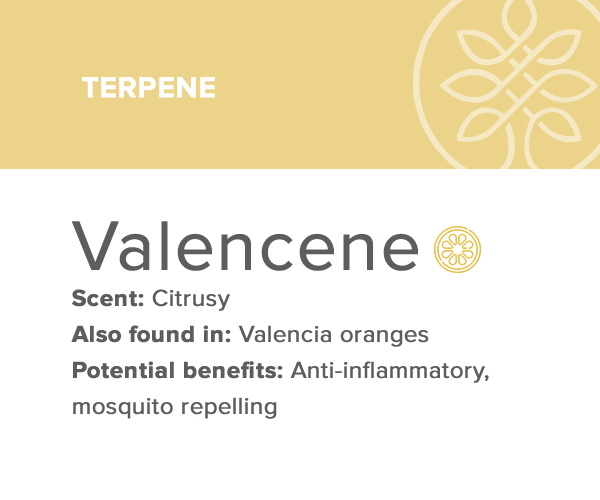 Scent: Citrusy
Scent: Citrusy
Also found in: Valencia oranges
Potential benefits: Mosquito repelling. More effects are currently being researched.
Terpinolene

Scent: Smoky, woody
Also found in: Nutmeg, tea tree
Potential benefits: Sedating, anti-bacterial, antioxidant, calming agent.
Geraniol
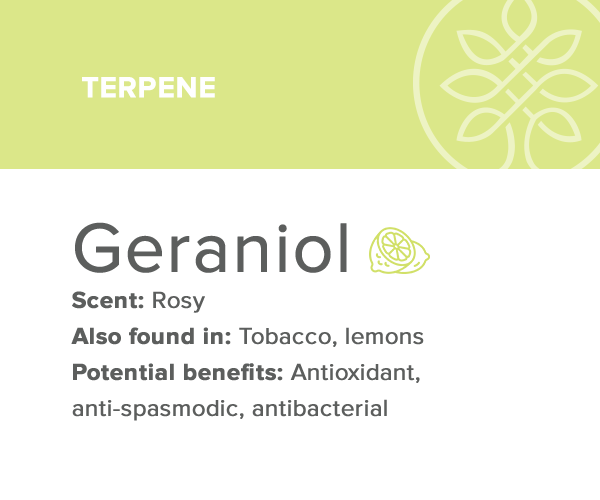 Scent: Rosy
Scent: Rosy
Also found in: Tobacco, lemons
Potential benefits: Antioxidant, anti-spasmodic, antibacterial, antifungal agent.
Terpineol
 Scent: Lilac
Scent: Lilac
Also found in: Lilac, eucalyptus
Potential benefits: Antioxidant, sedating, calming agent.
Does your CBD contain terpenes?
It depends. CBD isolate will never contain terpenes or any other cannabinoids besides CBD. Full-spectrum and broad-spectrum blends contain a variety of terpenes and flavonoids. However, not all broad-spectrum CBD is made equally. Growing and handling the hemp plant with care can make or break the terpene profile of CBD.
The female cannabis plant’s leaves and flowers contain glands called glandular trichomes that look like small hairs. These glands are a powerhouse, containing cannabinoids, terpenes and flavonoids – pretty much all the good stuff. If these trichomes are left intact with delicate handling of the plant, the resulting CBD blend will be rich with terpenes. How the plant is grown is important too, which is why it’s important to know where your CBD comes from. For terpenes to flourish, hemp requires the right amounts of humidity, light intensity and temperature.
Now that chemically synthesized terpenes are growing more common, manufacturers may isolate cannabinoids and then add terpenes later in the process. Plant-derived terpenes will likely be more beneficial than synthetic, lab-produced ones because of the entourage effect. Look for a brand that focuses on maintaining terpenes through the manufacturing process, rather than adding them after.
Looking for terpenes, but no THC?
A common misconception when it comes to terpenes is that one must consume CBD oil with a full-spectrum profile, which means it could include THC. However, this isn’t true. It’s entirely possible to produce effective, broad-spectrum CBD oil with no THC and a rich terpene profile. We would know – we make it!
Hempure utilizes supercritical CO2 to produce an extract rich in terpenes, CBD and other cannabinoids. This is followed by solvent removal by vacuum distillation. After the chlorophyll, waxes and THC are removed, we’re left with a PCR (phytocannabinoid rich) hemp oil with 60-80% CBD, minor cannabinoids, and terpenes. To accurately identify the profile of the oil and make sure all traces of THC are removed, Hempure’s facilities utilize a chromatography technique – the industry gold standard – to remove naturally occurring trace amounts of THC. At the same time, chromatography preserves the broad-spectrum profile of all non-psychoactive cannabinoids such as CBG, CBN, CBC and over 40 naturally preserved terpenes.
The benefits of terpenes could be talked about all day, but if you use any fragranced goods, you probably already know how great they can make you feel. If you’re looking for CBD oil that makes you feel better in an all-around, holistic sense, opt for one with terpenes. You won’t be disappointed.
[1] https://www.ncbi.nlm.nih.gov/pubmed/19962290
[2] https://www.ncbi.nlm.nih.gov/pmc/articles/PMC3523552/













